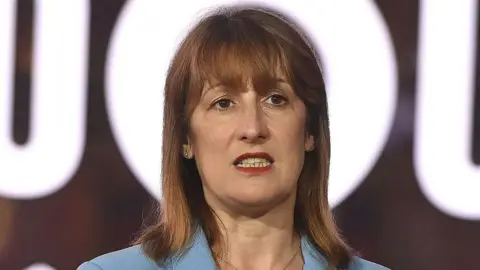Can the UK still claim to be the fastest-growing G7 economy?
52 minutes agoFaisal IslamEconomics editor•@faisalislam

 Getty Images
Getty ImagesHalf-full or half-empty? These latest UK gross domestic product (GDP) figures bring alive the classic metaphor about what exactly is in the glass.
The reality is that growth of 0.3% in the spring quarter between April and June is a slowing from the start of the year’s 0.7% expansion.
Yet at the same time, the news is positive because the economy had been expected to almost stop growing entirely, based on volatile monthly figures that had already been released.
The data for June was much better, which is encouraging, while the bad figure for April – initially showing a 0.3% fall – was revised up too.
So, to gauge contents of the proverbial glass, pick a timeframe.
The latest monthly figure is good, well above expectations, driven by the service sector.
The latest quarterly data show the economy growing, but slowly.
For the first half of the year, there has been solid growth overall during a fraught time, that exceeds that of other major economies.
My initial response to the data was that the chancellor and prime minister would now have to retire the “fastest growing G7 economy” line, because it was no longer true.
It appears it will be true across the first half of the year, pending final data from Japan.
Although this shifts the goalposts a bit, it can be justified.
One of the criticisms of the G7 boast in the first quarter was that the 0.7% number was flattered by a shift of exports to the US to earlier in the year to avoid potential tariffs as well as housing transactions to reflect stamp duty changes.
Melding the January-to-March and April-to-June figures does iron-out some of those one-off factors.
Combining both periods shows 1% growth which is more than the rest of the advanced economies. During a period of totally unprecedented global trade uncertainty, a possible oil shock, tax rises and wobbly policy u-turns, that’s solid growth.
It certainly isn’t consistent with the recessionary vibes given off in some quarters, which were given oxygen from the bad April GDP figure.
The problem is that the doom-mongering – some of it which can be traced back to Downing Street rhetoric from a year ago – could become self-fulfilling.
Consumer confidence has not been restored yet. There is a constant cycle of expectations of tax rises that do not help. The result is that UK consumers are saving a double-digit percentage of their income, which is basically pandemic level of savings.
Rising post-inflation incomes are yet to translate into a feel good factor and spending.
The trouble with taxes, worker-costs and job creation for the retail and hospitality industry is clearly very real.
These are very visible parts of the economy, and were disproportionately hit by the government’s policies so far, and have rolled back their opening of job opportunities, especially for younger people.
But these sectors are not the whole economy and June figures showed, for example, the IT industry doing well.
The latest quarter would also have been hit by a dramatic fall in car exports to the US which will recover in the coming months after the signing of the UK-US trade deal.
Better trade terms with the European Union and India should also help.
Further growth, albeit slow, is expected in the next few months.
So while it is not particularly fast, the recessionary vibes are off the mark too.
The question is now from this point, do consumers and businesses start to act more confidently with spending and investment?
That is still up for grabs.
More on this storyCost of Living UK economy